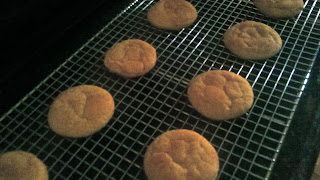I’ve recently taken up “golfing”…I use that term rather loosely as a round of golf for me generally consists of the following:
Stage 1: Feeling confused and overwhelmed with the tee off traffic and thus refusing actual game participation until roughly the 3rd or 4th hole.
Stage 2: Also known as the “serious” play stage and lasting approximately 2.3 holes, during which time I may have one really good drive (75+ yards) and some solid tries with the 7-iron and putter. This particular game stage inevitably comes to a close with something like an impressive 15-stroke par 4.
Stage 3: You may also want to refer to stage 3 as the tantrum phase. At this point, it’s best for me to pack it in or risk the very real possibility of impaling someone (accidentally, of course) with a 3-wood and subsequently ending up with a $10,000 lawsuit.
However, I have been putting lots of time in at the driving range with Zach and while I won’t be trying out for the LPGA any time soon, I have managed to improve a bit and I’m happy to report I can (almost) consistently make solid contact with the ball. Something about practice makes perfect seems to be repeating in my head at the moment.
But, I’m sure you’re asking yourself “What in the world does this have to do with baking?” Well, let me explain…
For the last several years, I have managed to perfect my version of the chocolate chip cookie, so for the second blog recipe I thought I’d share my tips for America’s favorite cookie. I set out to make them as always, remembering to incorporate all the little things that seem to make them come out just right every time, but upon tasting the first batch, they just weren’t as good as usual. Here’s where the golf analogy ties in – from my very limited golfing experience I’ve discovered that just when you think you’ve got one thing fixed something else goes wrong. Say you finally perfected your swing, but now your aim’s off or you’ve hit 8 great drives in a row, but can’t seem to even make contact with the ball on the 9th drive.
Baking is the same way; sometimes a batch just doesn’t turn out quite right. We have to remember baking is an artistic form of science and there are so many little things that can affect the outcome. So, next time your baking project doesn’t yield the results you want, don’t worry about it, it happens to all of us!
Chocolate Chip Cookies
2 1/4 cups all-purpose flour
1 teaspoon baking soda
1 teaspoon salt
1 cup (2 sticks) butter, softened
3/4 cup granulated sugar
3/4 cup packed brown sugar
1 teaspoon vanilla extract
2 eggs
2 cups semi-sweet chocolate chips
1 cup chopped nuts
Technique:
Combine flour, baking soda and salt in a small bowl and set aside. Beat butter, granulated sugar, brown sugar and vanilla in large mixing bowl until creamy. Add one egg at time, beating well between each addition. Gradually beat in flour mixture. Stir in chocolate chips and nuts. Refrigerate for 30 minutes.
Drop dough onto cookie sheet (approximately 1 heaping tablespoon of dough per cookie). Bake at 375 for 10 – 13 minutes or until golden brown.
Brittany’s Tips
- Melt butter in microwave for approximately 30 seconds before adding sugars and vanilla.
- Don’t over mix the dough. As soon as the last of the flour mixture is incorporated stop mixing.
- Make sure to refrigerate the dough before baking. This will ensure all batches bake evenly and turn out uniformly.
- When forming the dough, make sure all of your cookies are the same size.
- Take the cookies out of the oven a little before you think you should and then set the timer for 2 minutes and let them continue baking on the hot cookie sheet. They'll darken up as they sit and cool.
Happy Baking!




